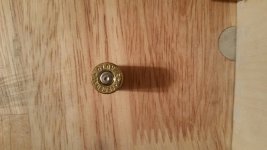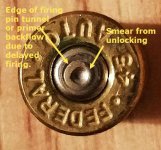I was recently at the range testing some hand loads. The primer looks as if it is flowing. Is this possibly a firing pin shape problem, an oversized firing pin hole or maybe just a little too much powder. I was using 6.9 grains of power pistol and a 230 grain fmj round nose. Also seemed like i was getting a lot of unburned powder. The gun was filthy. Speeds averaged around 950 fps. Some of the cases were also discolored like they had gotten really hot.
You are using an out of date browser. It may not display this or other websites correctly.
You should upgrade or use an alternative browser.
You should upgrade or use an alternative browser.
Primer Looks Like Possible Overload
- Thread starter SAGW
- Start date
ligonierbill
New member
What are you shooting? I am getting 870 with a 230 Hornady XTP over 6.9 gr PP out of a 5" Springfield Range Officer. Your velocity seems a bit high for that powder load. Hornady lists 7.1 PP as max with 230's, Speer higher, so this should not be an overpressure load. But yes, that primer sure looks over pressure. Are you sure of the powder charge? Rounds feeding OK? (Not being pushed back into the case somehow.) I would not fire any more of those loads until I figured out the problem.
I am shooting a Colt Government Model Mark IV Series 70. I may be a little off on the speeds. I am going off of memory. I had my chronograph and my log but forgot to bring something to write with. I was also testing different loads and calibers. The 870 FPS sounds about right. I have basically rebuilt the entire gun. At the time of the test it had a Storm Lake match grade barrel and bushing which I just recently replaced with an Ed brown barrel and bushing. It did have a few feeding problems and a couple doubles from what I believe to be follow down. I think I have fixed that problem, I just haven't been back to the range to verify. I also don't have any more of those loads. I only loaded a hand full to test before I loaded a bunch of them, but most exhibited this problem. I don't recall it happening with factory ammo. I am also using CCI Large Pistol primers which I am told are a little harder than the Winchester primers. I don't have have any evidence to back that up though.
Last edited:
g.willikers
New member
There's definitely no signs of flattened primers, quite the opposite.
And no breach face marks on the case.
Both are generally indications of hot loads.
If factory loads aren't doing it, too, then it's pretty obvious it's your reloads.
If factory loads were doing it, maybe the chamber dimensions should be checked, especially headspace.
Mebbe.
And no breach face marks on the case.
Both are generally indications of hot loads.
If factory loads aren't doing it, too, then it's pretty obvious it's your reloads.
If factory loads were doing it, maybe the chamber dimensions should be checked, especially headspace.
Mebbe.
Last edited:
Gunplummer
New member
It looks like slag off the firing pin pressed on the primer. It is only a photo, but that is what it looks like.
I think it's something like that, too. The outer perimeter of the primer is a well-rounded edge. Check the pistol breech face to be sure a divot has come out of it around the firing pin tunnel.
The rounded primer edge plus the very dirty burn says low pressure. QuickLOAD gives it about 15,000 psi with 26 grain case capacity and 868 fps from a 5 inch tube with the burn rate up 5% over model. Power Pistol, IME, likes running closer to the upper limit at near 21,000 psi or even up into +P territory. The slower the powder the higher the pressure needed for a clean burn.
The rounded primer edge plus the very dirty burn says low pressure. QuickLOAD gives it about 15,000 psi with 26 grain case capacity and 868 fps from a 5 inch tube with the burn rate up 5% over model. Power Pistol, IME, likes running closer to the upper limit at near 21,000 psi or even up into +P territory. The slower the powder the higher the pressure needed for a clean burn.
At what PSI would one start to see Over-Pressure signs in a 45acp Primer?
MAP for the 45acp is 21K psi. The 10mm, which uses the same primer, has a MAP of 37.5K psi.
How does the primer know to show Over pressure in the 45acp above 21K psi, and wait until pressures exceed 37.5K psi in the 10MM?
Are they really that smart?
MAP for the 45acp is 21K psi. The 10mm, which uses the same primer, has a MAP of 37.5K psi.
How does the primer know to show Over pressure in the 45acp above 21K psi, and wait until pressures exceed 37.5K psi in the 10MM?
Are they really that smart?
It is irrationally vague "science" to grab one primer from one load, shot in one pistol and attempt to read the tea leaves in it.
Reading primers makes the most sense when it's relative. So I would suggest that you compare those primers to brass of:
same pistol
same headstamp
same bullet
same COAL
same primer
^from same production lot
...using lesser charges of the same powder.
Look for changes in what you see as you advance a load.
For the luvva all that is holy, please do not look at a .45 ACP handload and try to gain insight in the look of the primer compared to a piece of 10mm fired brass.
Reading primers makes the most sense when it's relative. So I would suggest that you compare those primers to brass of:
same pistol
same headstamp
same bullet
same COAL
same primer
^from same production lot
...using lesser charges of the same powder.
Look for changes in what you see as you advance a load.
For the luvva all that is holy, please do not look at a .45 ACP handload and try to gain insight in the look of the primer compared to a piece of 10mm fired brass.
maybe just a little too much powder
After you pull the trigger there is nothing I can do to help you in the way of advise. Before you pulled the trigger you could have weighted the loaded rounds. To make any sense of the results when weighing loaded ammo the reloader must know the weight of the components.
Point? The only spread in weight I am looking for is the weight of powder. The saddest words of verse or pen at the firing range is: "Must have been a double charge".
F. Guffey
buck460XVR
New member
Primers are a poor judge of pressure in handgun loads. How far did the gun fling the brass as compared to other loads? I can tell the power level of my handloads outta my Colt 1911, by the distance the brass flies.
Timing, the barrel unlocked to soon.I have basically rebuilt the entire gun. It did have a few feeding problems and a couple doubles from what I believe to be follow down. I think I have fixed that problem,
g.willikers
New member
Explain, please.Timing, the barrel unlocked to soon.
I see what he means, but don't think the unlocking was early. That usually elongates the firing pin indentation itself. The more I look at it the more I think what I am seeing is one of two things. One is that the firing pin retracted while there was still pressure in the barrel with the result that the primer tried to flow into the firing pin tunnel, then was smeared when the gun unlocked. But that circle looks large for a 1911 firing pin tunnel. The other mechanism that occurred to me was the firing pin struck normally, but ignition did a few miliseconds of hang-fire, letting the pin retract, then it went off and pushed the primer indentation most of the way back out, with the sided of the indentation flattening against the breech face, then getting smeared on unlocking. Not a great explanation, but those are the two that would explain the raised center around the firing pin indentation and the smear. I can't say I've ever seen this, and I've put a lot of .45 Auto down range through several 1911's, including a Series '70.
I enlarged and adjusted contrast and sharpness for a better look. Here's what I got:

I enlarged and adjusted contrast and sharpness for a better look. Here's what I got:
Attachments
I've seen them. It just takes the pin failing to retract completely before unlocking starts. New firing pin spring can help in some cases. The unlocking delay from using a square bottom firing pin stop helps. Wimpy mainspring can be an issue as the pin doesn't rebound as smartly.
Power Pistol in 45 ACP
 http://www.alliantpowder.com/reloaders/powderlist.aspx?type=1&powderid=8&cartridge=35 Alliant Data
http://www.alliantpowder.com/reloaders/powderlist.aspx?type=1&powderid=8&cartridge=35 Alliant Data
A slow burn rate powder will do this at starting loads.I was using 6.9 grains of power pistol and a 230 grain fmj round nose. Also seemed like i was getting a lot of unburned powder. The gun was filthy.
Last edited:


